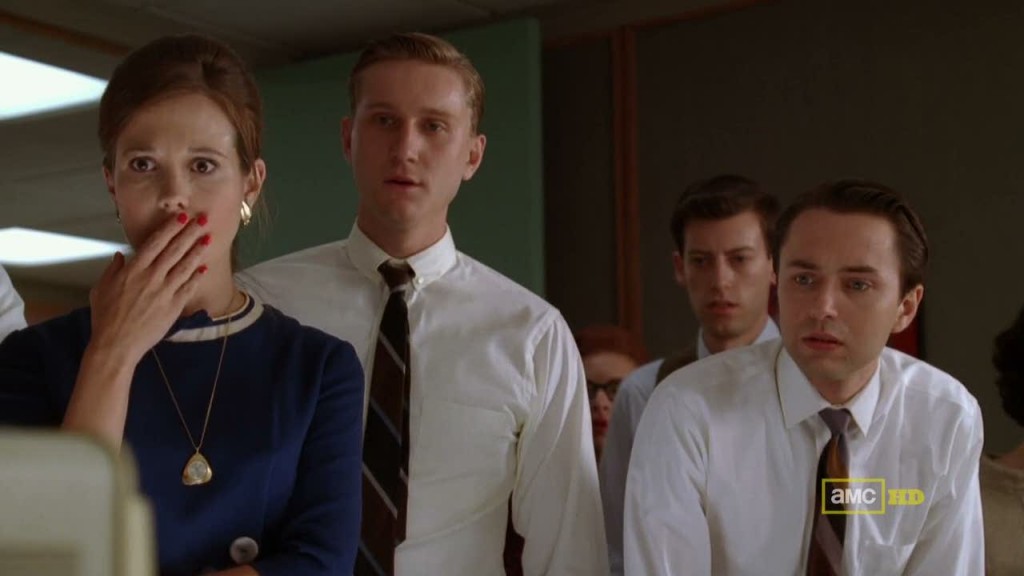TELEVISION CULTURES:
BLOG POST 2
A CONCEPT OR ISSUE (LIVENESS)
On November 22nd, 1963, in Texas, USA, the president of the United States was shot dead by an assassin. 50 years on, the media world continue to reenact the exact moment it happened, the immediate aftermath it caused and how it affected one of the world’s most powerful countries.
TV show ‘Mad Men’ (a series about the high-pressure world of advertising in 1960’s New York) and the 2013 movie ‘Parkland’, both showed head-on what the day of the Kennedy assassination would have felt like. Each one emphasised on the concept of ‘liveness’, showing both havoc, chaos and emotion in the characters, and seeping that emotion into viewers watching in the 21st century, who may or may not have even been born during that time!
The sense of extremity and urgency happening in both the series episode and the ‘Parkland’ movie was used to evoke fear and shock in an audience who already knew of this event, yet would feel like they were experiencing it for the first time. I first watched ‘The Grown-Ups’ episode of Mad Men a couple of years ago, yet the strong emotions I had towards the storyline and the characters during that very moment are still imprinted in my mind to this day. (Let’s not get into too much dramatic detail…)
 The JFK assassination was what transformed media coverage and allowed the notion of broadcasting non-stop breaking news live from the scene to be of reality. Similar to the 2014 Sydney Lindt cafe hostage crisis, where commercials were suspended and there were wall-to-wall reportage of the unfolding events, the 1963 matter also made all major television networks follow the concept of “letting images do the talking” and having the anchors talk off-screen. The reason for this is because it was a clear disruption of the everyday routine that many news shows abide by, which made viewers tuning in become immediately captivated because of how “strange” the usual TV conventions have become. This is evident in the statistics given by the Daily Mail, where 45.4 percent of U.S homes with a television set had it turned on when the White House confirmed Kennedy’s death, and the numbers doubled to 81 percent as his coffin arrived at Arlington National Cemetery three days later. This sense of frightening liveness would go unmatched until the morning of September 11, 2001.
The JFK assassination was what transformed media coverage and allowed the notion of broadcasting non-stop breaking news live from the scene to be of reality. Similar to the 2014 Sydney Lindt cafe hostage crisis, where commercials were suspended and there were wall-to-wall reportage of the unfolding events, the 1963 matter also made all major television networks follow the concept of “letting images do the talking” and having the anchors talk off-screen. The reason for this is because it was a clear disruption of the everyday routine that many news shows abide by, which made viewers tuning in become immediately captivated because of how “strange” the usual TV conventions have become. This is evident in the statistics given by the Daily Mail, where 45.4 percent of U.S homes with a television set had it turned on when the White House confirmed Kennedy’s death, and the numbers doubled to 81 percent as his coffin arrived at Arlington National Cemetery three days later. This sense of frightening liveness would go unmatched until the morning of September 11, 2001.
When live footage is captured and replayed, an emotional moment that happened months or years ago, becomes an emotional moment in the current day, because film has the ability to create this illusion. When you are watching a film, you are stepping out of your own perception and plugging yourself into the director’s/character’s perspectives. This is the reason why it continues to resonate in people’s minds now, because the mystery was never completely solved, and there are still theories going around it today.
The difference between how ‘Mad Men’ and ‘Parkland’ treated the event was the fact that ‘Parkland’ dove into the lives of the doctor who tried to save John. F Kennedy, the family of Lee Harvey Oswald and the detective who may or may not have let Oswald go months before the murder, whereas ‘Mad Men’ showed the reaction of people who were not personally related, but were still exposed to deep personal grief.
The concept of live television reveals moments of patriotism and nation-building, due to the shared experience viewers were having – especially because it was such a tragic event, and we all know that misery loves company.
Reference:
Daily Mail. 2013. How the JFK assassination transformed media coverage: The idea of broadcasting live breaking news was born. [ONLINE] Available at: http://www.dailymail.co.uk/news/article-2511916/How-JFK-assassination-transformed-media-coverage-Broadcasting-live-breaking-news-born.html. [Accessed 13 August 15].

